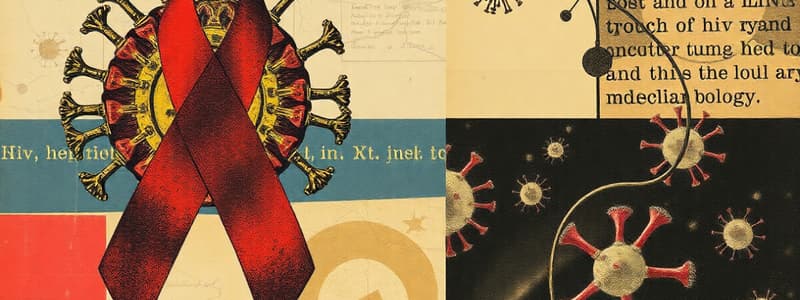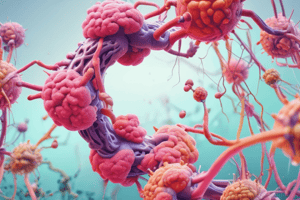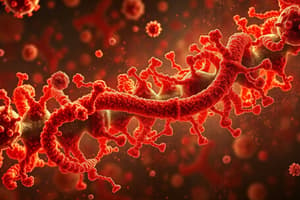Podcast
Questions and Answers
What does a CD4+ count of greater than 500 cells/uL indicate in the clinical categories of AIDS?
What does a CD4+ count of greater than 500 cells/uL indicate in the clinical categories of AIDS?
- Category B2
- Category B1 (correct)
- Category C1
- Category A1 (correct)
What is the normal range for CD4+ T cells in adults?
What is the normal range for CD4+ T cells in adults?
- 400–1000 cells/uL
- 500–1500 cells/uL
- 300–600 cells/uL
- 600–1200 cells/uL (correct)
In order to stabilize leukocytes during the diagnostic process, which method is used?
In order to stabilize leukocytes during the diagnostic process, which method is used?
- Stabilizing with paraformaldehyde (correct)
- Heating with ethylene oxide
- Washing with saline solution
- Cooling with ice
Which clinical category corresponds to a CD4+ count of 200-499 cells/uL?
Which clinical category corresponds to a CD4+ count of 200-499 cells/uL?
What is the significance of the red lines in the diagram pertaining to HIV?
What is the significance of the red lines in the diagram pertaining to HIV?
What is the primary mode of HIV transmission worldwide?
What is the primary mode of HIV transmission worldwide?
Which factor increases the likelihood of HIV transmission during sexual activity?
Which factor increases the likelihood of HIV transmission during sexual activity?
How is HIV transmitted through blood and body fluids?
How is HIV transmitted through blood and body fluids?
What is the average risk of HIV transmission to health workers through percutaneous exposure?
What is the average risk of HIV transmission to health workers through percutaneous exposure?
What is vertical transmission of HIV?
What is vertical transmission of HIV?
What is the minimum amount of saliva mentioned to potentially transmit HIV?
What is the minimum amount of saliva mentioned to potentially transmit HIV?
What role does the vpu protein play in HIV-1?
What role does the vpu protein play in HIV-1?
What is the risk percentage of HIV transmission through mucous membrane exposure for health workers?
What is the risk percentage of HIV transmission through mucous membrane exposure for health workers?
What is the shape of the HIV-1 virion?
What is the shape of the HIV-1 virion?
Which gene is responsible for enhancing the transcription of viral proteins?
Which gene is responsible for enhancing the transcription of viral proteins?
Which gene codes for the proteins necessary for reverse transcription?
Which gene codes for the proteins necessary for reverse transcription?
What role does the vif gene play in HIV?
What role does the vif gene play in HIV?
What function does the REV gene serve in the HIV lifecycle?
What function does the REV gene serve in the HIV lifecycle?
Which of the following is not essential for viral replication but enhances the virus's capacity to survive?
Which of the following is not essential for viral replication but enhances the virus's capacity to survive?
What does the LTR sequence provide for the HIV genome?
What does the LTR sequence provide for the HIV genome?
How does the vpr gene affect HIV replication?
How does the vpr gene affect HIV replication?
Which cells do X4 strains of HIV primarily bind to?
Which cells do X4 strains of HIV primarily bind to?
Which gene produces the envelope glycoprotein in HIV?
Which gene produces the envelope glycoprotein in HIV?
What role do chemokine receptors play in HIV infection?
What role do chemokine receptors play in HIV infection?
What is the primary component of the HIV lipid envelope derived from?
What is the primary component of the HIV lipid envelope derived from?
What is the function of the HIV enzyme reverse transcriptase?
What is the function of the HIV enzyme reverse transcriptase?
Where is the HIV RNA housed within the virus?
Where is the HIV RNA housed within the virus?
Which chemokine receptor primarily interacts with macrophages during HIV infection?
Which chemokine receptor primarily interacts with macrophages during HIV infection?
What does gp120 binding trigger in the HIV life cycle?
What does gp120 binding trigger in the HIV life cycle?
What is the role of the HIV envelope in the virus's structure?
What is the role of the HIV envelope in the virus's structure?
Which type of HIV strain primarily interacts with dendritic cells?
Which type of HIV strain primarily interacts with dendritic cells?
What characterizes the acute infection stage of HIV infection?
What characterizes the acute infection stage of HIV infection?
What is a key feature of the clinical latency stage of HIV infection?
What is a key feature of the clinical latency stage of HIV infection?
At what CD4+ T cell count is a patient diagnosed with AIDS?
At what CD4+ T cell count is a patient diagnosed with AIDS?
Which of the following is NOT a symptom experienced during the acute infection stage?
Which of the following is NOT a symptom experienced during the acute infection stage?
Which stage follows the clinical latency stage in HIV progression?
Which stage follows the clinical latency stage in HIV progression?
What occurs in the body during the AIDS stage of HIV infection?
What occurs in the body during the AIDS stage of HIV infection?
During which stage of HIV infection is a person most likely to be asymptomatic?
During which stage of HIV infection is a person most likely to be asymptomatic?
What is the primary consequence of the cell membrane damage due to HIV?
What is the primary consequence of the cell membrane damage due to HIV?
Flashcards are hidden until you start studying
Study Notes
HIV Structure
- HIV-1 virion is spherical, composed of an electron-dense, cone-shaped core enclosed by a lipid envelope derived from the host cell membrane.
- Genes essential to viral replication:
- TAT gene: Enhances the transcription and expression of viral proteins by binding to the TAR.
- REV gene: Post transcriptional activator for splicing and transportation of viral mRNA (production of structural proteins)
- LTR sequence: Promoter and enhancer elements
- gag gene: Codes for the group-specific antigen
- pol gene: Codes for reverse transcriptase, protease, and integrase
- env gene: Codes for the envelope glycoprotein (gp)
- Genes not essential to viral replication (but enhance the capacity of the virus to survive):
- Virus infection factor (vif): Makes the virus more infectious
- Negative factor (nef): Inhibits or activates viral transcription as required, influences t cell activation, reduces CD4 expression
- vpr: Controls the rate of replication
- vpx: Specific to HIV 2, controls the rate of replication
- vpu: Specific to HIV 1, contributes to viral release, increases CD4 turnover.
HIV Transmission
- Can be transmitted through:
- Intimate sexual contact:
- 85% of transmissions are through heterosexual contact worldwide.
- Transmission is more likely when STIs are present because of lesions in the genitals.
- Contact with blood or other body fluids:
- Sharing of contaminated needles.
- Average risk of transmission to healthcare workers:
- 0.3% percutaneous exposure (needle stick).
- 0.09% mucous membrane exposure.
- Perinatally, infected mother to infant (vertical transmission).
- Saliva is assumed to have a low risk of transmission.
- Intimate sexual contact:
HIV Binding and Fusion
- gp120 (HIV) binds to CD4 T cells (T tropic/X4 strains) and other cells (M tropic/R5 strains): macrophages, monocytes, dendritic cells, Langerhans cells and microglial cells.
- Fusion:
- Requires chemokine receptors:
- CXCR4: For T-cells
- CCR5: For macrophages
- Occurs when chemokine receptor binds to gp120 and gp41
- Requires chemokine receptors:
Reverse Transcription
- HIV capside: Bullet shaped core that contains HIV RNA
- HIV envelope: Outer surface of HIV
- HIV enzymes: Proteins that carry out steps in the HIV life cycle
- HIV glycoproteins: Protein spikes on HIV envelope
- HIV RNA: HIV's genetic material
- Viral contents gain entry to the host membrane.
- HIV RNA unravels followed by reverse transcription.
- Enzyme reverse transcriptase produces complementary DNA (cDNA) from the viral RNA.
Stages of HIV Infection
- Acute infection stage/primary HIV infection:
- Flu-like symptoms: fever, swollen glands, sore throat, rash, muscle and joint pains, fatigue, headache.
- Clinical latency stage/chronic HIV infection: Asymptomatic HIV infection
- AIDS (terminal stage):
- CD4+ cells fall below 200 cells/mm3.
- RNA copies rise.
- One or more opportunistic illnesses develop, regardless of CD4 count (AIDS defining disease).
Diagnostic Definitions of AIDS
- Adults:
- Serves as a clinical diagnosis.
- Table 5. Categories of AIDS:
- CD4+ T cells/ul | Clinical Categories
-
500 | A1 | B1 | C1
- 200-499 | A2 | B2 | C2
- Data shows the majority of cases are in individuals aged 25-34 years old.
- Minimal risk of transmission in pregnant women, but children can be infected at birth.
Serodiagnosis of HIV
- Diagnostic definition:
- Signals are interpreted by the machine.
- Removing erythrocytes by lysis.
- Stabilizing leukocytes by fixation with paraformaldehyde.
- Normal: 600-1200 cells/uL
Studying That Suits You
Use AI to generate personalized quizzes and flashcards to suit your learning preferences.




